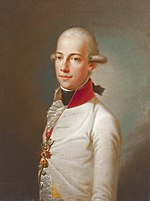Franz von Lauer
Franz von Lauer | |
|---|---|
Feldzeugmeister | |
| Battles/wars |
|
| Awards | Military Order of Maria Theresa, KC 1789, CC 1795 |
Franz von Lauer (11 May 1736 – 11 September 1803) entered the
During the
Pre-French Revolutionary Wars career
Born in 1736, Lauer studied at the
War of the First Coalition

Lauer fought on the upper
When the
After the War of the First Coalition Lauer became the Director-General of Engineers, a post that he held from April 1797 to February 1801.[2]
War of the Second Coalition

When the
While the truce remained in force, the Austrians engaged in futile peace negotiations while preparing to renew the war. Francis wanted Archduke Charles to lead the army, but Charles declined because he doubted the Austrian army was strong enough to contend with France. Instead, Francis selected Charles' inexperienced 18-year-old brother, Archduke John of Austria as commander, and made Lauer his second-in-command, calling him "the most innovative man in the art of war".[10] Francis chose John hoping that his status would end the tendency of senior officers to discuss orders and obey them only if they agreed. At the same time, he expected John to remain a mere figurehead while Lauer made the important decisions, creating a very awkward command structure.[7]
Lauer was promoted

In the Austrian army, the line regiments had been brought up to their authorized strengths and additional light infantry units were raised. The main field army counted 49,000 infantry and 16,500 cavalry while additional forces guarded the flanks. Franz von Weyrother, Archduke John's chief-of-staff, persuaded John and Lauer to adopt an offensive strategy to turn the French left flank.[13] Weyrother's strategy was good on paper, but it did not take into account the limitations of the Habsburg army. The heavy rains combined with hard marching caused desertions, serious straggling, and tired out the troops before the coming battle. Meanwhile, the army's artillery and wagon trains fell behind. Lauer convinced John to abandon Weyrother's flanking strategy and advance directly on Munich. Despite the difficulties, the Austrians approached Hohenlinden with a slight numerical advantage, even though the French outnumbered them in south Germany.[14]
The Austrians scored a costly victory over the French at the Battle of Ampfing on 1 December 1800. Lauer pointed out that in the heavily wooded country, the Austrian cavalry and artillery would be ineffective. His concerns were brushed aside by Weyrother and his clique. The success at Ampfing made John and his staff reckless in their zeal to get to grips with Moreau. Lauer remained cautious but found himself unable to impose his views on the army headquarters.[15] On 3 December, the Austrians split into four separate columns, none of which were able to support each other, and advanced through rough terrain to open the Battle of Hohenlinden.[16] Moreau's army ambushed the Austrians and enveloped their principal column, inflicting a decisive defeat.[17] After a vigorous French pursuit, Imperial morale collapsed, with the French taking 20,000 prisoners. On 17 December, Archduke John was removed from command and replaced by his brother Charles. On 24 December, Emperor Francis authorized Charles to request an armistice and Moreau accepted it the next day. Bonaparte forced Austria to swallow harsh terms at the Treaty of Lunéville in February 1801.[18]
Blamed for the disaster, Lauer retired from the army in 1801. He died in Krems an der Donau on 11 September 1803. He married Maria d'Allio.[2] His son Joseph von Lauer (1769–1848) was promoted to Major in 1800 and retired from the Austrian army in 1847 with the rank of Feldzeugmeister.[19]
Notes
- ^ Arnold 2005, pp. 205–206.
- ^ a b c d e Smith & Kudrna 2008a.
- ^ Smith 1998, p. 61.
- ^ Boycott-Brown 2001, p. 406.
- ^ Boycott-Brown 2001, pp. 415–416.
- ^ Boycott-Brown 2001, pp. 420–435.
- ^ a b c Arnold 2005, p. 206.
- ^ Chandler 1966, p. 121.
- ^ Arnold 2005, pp. 197–203.
- ^ Arnold 2005, pp. 204–205.
- ^ Arnold 2005, p. 208.
- ^ Arnold 2005, pp. 210–211.
- ^ Arnold 2005, p. 213.
- ^ Arnold 2005, p. 214.
- ^ Arnold 2005, pp. 217–221.
- ^ Arnold 2005, pp. 221–222.
- ^ Arnold 2005, pp. 237–242.
- ^ Arnold 2005, pp. 256–258.
- ^ Smith & Kudrna 2008b.
References
- Arnold, James R. (2005). Marengo & Hohenlinden: Napoleon's Rise to Power. Barnsley, South Yorkshire: Pen and Sword. ISBN 1-84415-279-0.
- Boycott-Brown, Martin (2001). The Road to Rivoli: Napoleon's First Campaign. London, UK: Cassell & Co. ISBN 0-304-35305-1.
- Chandler, David G. (1966). The Campaigns of Napoleon. New York, N.Y.: Macmillan.
- ISBN 1-85367-276-9.
- Smith, Digby; Kudrna, Leopold (2008a). "Austrian Generals of 1792-1815: Franz Freiherr von Lauer". napoleon-series.org. Retrieved 8 July 2021.
- Smith, Digby; Kudrna, Leopold (2008b). "Austrian Generals of 1792-1815: Joseph Freiherr von Lauer". napoleon-series.org. Retrieved 8 July 2021.
